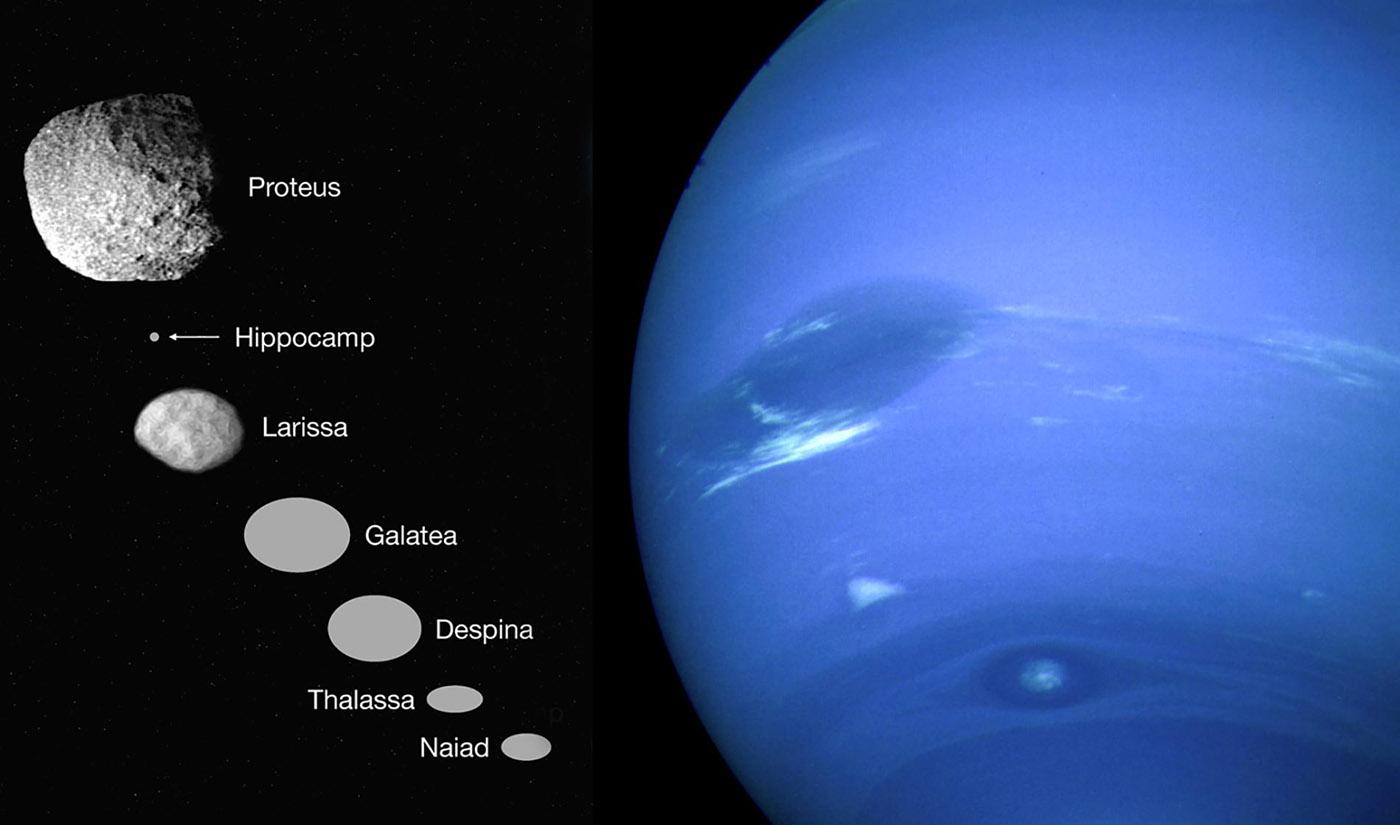
A moon, unknown until it was detected in 2013, has been given its official name, one that comes from of Greek mythology. The International Astronomical Union (IAU) recently approved the name proposed by its discoverer and SETI Institute senior research scientist and fellow Mark Showalter, as reported by Gizmodo:
“The names of Neptune’s inner moons come from mythology of the seas,” Showalter told Gizmodo. “‘Hippocamp’ was approved by the International Astronomical Union because it is the name for that half-horse, half-fish creature that the god Neptune was often depicted riding on in Roman mosaics.”
For Showalter, a scuba diver who loves exploring underwater worlds as much as the cosmos, the name carries an additional significance, according to Space.com:
"So, officially, it's named after this mythological creature," Showalter told Space.com. "But partly, in my mind, it's named after seahorses, because I think they're cool."
Why did Hippocamp remain undiscovered for so long? The tiny moon is only 20 miles wide, about the size of the Kuiper belt object the NASA’s New Horizons spacecraft flew by on New Year’s Day, Ultima Thule (Showalter led that mission’s hazard team). It was missed by NASA’s Voyager 2 spacecraft when it flew past in 1989 (although the probe did discover 6 other moons at the time). As Space.com reports, to find Hippocamp Showalter combed over images taken by Hubble – but that posed challenges too:
"We came really close to missing it entirely," Showalter said of Hippocamp. "It's too faint to see in a single Hubble [exposure]."
Showalter’s team developed a technique of taking multiple images and stacking them on top of each other, to amplify the exposure. The result was “a dot” that appeared to be an unidentified moon.
While future missions to orbit the icy outer worlds of our Solar System will likely be needed to see the petite moon in detail, we can infer a little about its strange nature – Hippocamp orbits close to Proteus, which like our own moon, is slowly drifting further from its planet. Showalter and his team suspect that it was ejected from Proteus and created as a result of the same collision (possibly with a comet) that created the Pharos Crater on the larger moon. In fact, Hippocamp may have been destroyed and reformed multiple times over its history.
To learn more about Hippocamp’s discovery and how it may have formed, you can watch Mark Showalter’s interview with SETI senior research scientist Matt Tiscareno on an episode of #SpaceBook Live.
- SETI.org: Tiny Neptune Moon Spotted by Hubble May Have Broken from Larger Moon
- Nature: The seventh inner moon of Neptune
- Nature: A new moon for Neptune
- National Geographic: Meet the newest known moon of Neptune
- The Atlantic: A City-Size Moon Was Hiding Around Neptune
- Gizmodo: Neptune's Smallest Moon Finally Has a Name: Hippocamp
- YouTube (Video): Hubble ESA: Animation of Neptune’s moon Hippocamp
- Space.com: Meet Hippocamp! Neptune's Smallest Moon Has a Name (and a Violent Past)
- Ars Technica: Hubble images show a Neptune moon that may have been repeatedly reborn
- Phys.org: Neptune's newest, tiniest moon likely piece of bigger one
- New Atlas: Say hello to Hippocamp, Neptune's newest moon
- Motherboard: Astronomers Officially Name the Newest Moon of Neptune
- Astronomy Magazine: Meet Neptune's new moon, Hippocamp
- The Verge: Neptune’s newly discovered moon may be the survivor of an ancient collision
- The Independent: New Moon Found in our Solar System: Scientists Unveil ‘Hippocamp’ Floating Around Neptune
 Andrew Siemion Discusses Alien Life on Voice of Islam Radio
Andrew Siemion Discusses Alien Life on Voice of Islam RadioAndrew Siemion, Bernard M. Oliver Chair for SETI Research at the SETI Institute and Director of the U.C. Berkeley SETI Research Center, appeared on Voice of Islam Radio in an episode of The Breakfast Show. The program hosts a wide-ranging conversation about the possibility of life beyond Earth, and Siemion joins to answer questions about Fermi’s paradox, whether it’s possible visitors might have already visited Earth, and if extraterrestrials are likely to be friendly. The conversation starts at about 20:00, and Siemion joins at approximately 48:00.
- Voice of Islam: The Breakfast Show 20-02-2019
Two articles highlighted contributions to the SETI field by the Arecibo Observatory, a radio telescope in Puerto Rico. The first, published by Vox, reported a project by the observatory’s researchers to craft a new Arecibo Message by recruiting teams of kids from around the world to submit their designs. The very simple original message was the most powerful broadcast ever deliberately beamed into space, and was broadcast in 1974. Vox noted the role of Frank Drake, SETI pioneer and Chair Emeritus of the SETI Institute Board of Trustees:
When space scientists wanted to celebrate a huge upgrade that had been made to the Arecibo Observatory in 1974, two of their greatest minds stepped up to draft a memo to aliens. It would be broadcast from the telescope during a public ceremony. Frank Drake, who came up with the famous “Drake Equation” for estimating the odds that intelligent life exists in our galaxy, crafted the message with help from Carl Sagan, the astronomer and popular science writer who penned Contact and popularized the Search for Extraterrestrial Intelligence (SETI) organization.
Today, the observatory is holding a global contest to encourage youth engagement in science, and to draw public attention to the observatory following its recovery from Hurricane Maria, which battered Puerto Rico in 2017. While the island is still struggling to recover more than a year after the devastating storm, the observatory remains operational, as its damage was relatively minor. As for the message itself, it may or may not actually get transmitted – METI (messaging extraterrestrial intelligence) remains controversial, and international consensus would likely be needed prior to future transmissions from Arecibo.
Interesting Engineering also published an article discussing the Arecibo message, as well as a lengthy summary of the historical highlights in the modern search for intelligent life beyond Earth. The article covers important moments from Frank Drake’s groundbreaking experiment in radio signal detection, Project Ozma, to current and future initiatives in the broader search for technosignatures.
- Vox: Astronomers are asking kids to help them contact aliens
- Interesting Engineering: How Do We Search for Intelligent Life?
In last week’s episode, a look at the scientific ideas that came before their time and shook the world, in Radical Cosmology. On our previous week’s episode, explore the good and bad ways technology is increasingly encroaching into our lives in Keeping Humans in the Loop.
Last time on Facebook Live, SETI senior research scientist Matt Tiscareno interviews senior research scientist and fellow Mark Showalter to discuss the recently named Neptunian moon, Hippocamp. Videos of all past Facebook Live events can be found on our Facebook page: https://www.facebook.com/SETIInstitute/
- Silicon Valley Astronomy Lecture Series: February 27, 2019, Foothill College, Los Altos Hills, CA Penelope Boston of the NASA Astrobiology Institute will offer the talk "The Worlds Under Our Feet: Caves from Earth to Mars and Beyond"
- San Mateo County Astronomical Society: March 1, 2019, College of San Mateo, San Mateo, CA SETI Institute scientist Michael Busch will present Near Earth Asteroid Hazards, Research and Space Missions
- Kepler &K2 Science Conference V: March 4-8, 2019, Glendale, CA SETI Institute scientist Douglas Caldwell will present The Kepler Photometer
- 50th Lunar and Planetary Science Conference: March 18-22, 2019, The Woodlands, TX Numerous SETI Institute scientists will be presenting their work
- Third Thursday: Extopia: March 21, 2019, San Jose, CA A virtual reality installation produced in collaboration with Scott Kildall, former SETI Artist in Residence, and Franck Marchis, SETI Institute scientist





